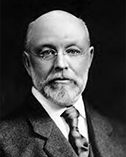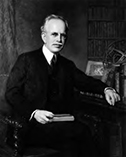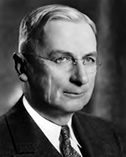
 Ira Remsen
Ira Remsen
1907-1913 NAS President
The Academy selected New York born Ira Remsen (1846–1927), an organic chemist, to lead the institution through its semi-centennial anniversary in 1913. At the time, he was serving as president of the Johns Hopkins University, which he had joined as its first professor of chemistry in 1876. As was customary at the period, part of his education was carried out in the United States, but he continued it by spending several years in Europe where he learned much while working there in some of the relatively advanced research laboratories.
On returning to United States in 1872, he chose a faculty position at Williams College in Massachusetts on the prospect that it might soon start a graduate school and allow him to have graduate students and a suitable chemistry laboratory. When this did not materialize, he decided to accept a position at Johns Hopkins University, which was planning to pattern itself after the German universities of the period. He soon built up a fine reputation as a research chemist, teacher, and administrator. His laboratory was a prolific source of well-prepared organic chemists. As a result, he was selected as the second president in 1901 on the retirement of the founding president Daniel Coit Gilman. In the course of his academic career, which also involved a period as president of the University of California, Gilman had exerted a revolutionary influence on higher education in the country. He served as the first president of the Carnegie Institution in Washington, D.C., founded in 1902.
Included in Remsen's extensive chemical research was the discovery of the super-sweetener saccharine, made with a colleague.
Control of Commercial Trusts
This was a period in which much public concern arose regarding the growing power of the great industrial trusts. There was fear that they might gain too much political and economic control in the nation. The discussion ended in the formulation of antitrust laws that have acted to prevent the development of monopolies, or to regulate their actions when monopolies are inevitable, as was essentially once the case for the telephone system. This was also a period in which the so-called muckraking reporters began to raise questions about the conditions under which most of our everyday foods are produced. Again, new regulations were introduced, most of which have been expanded and tightened in the intervening years. The first Pure Food and Drug Act was passed in 1906.
In the same period, the Congress noted once again the ever-increasing role that science and scientists were playing in the various governmental agencies and requested the Academy once again to determine if a significant amount of consolidation was now reasonable. To lead the task in this instance, Remsen selected Dr. R. J. Woodward (1849–1924), the incumbent president of the Carnegie Institution. Again the committee decided that real duplication in scientific effort was very limited since different agencies had different problems and goals. It did, however, go so far as to recommend that an appropriate watchdog committee be created. Through mischance the matter never reached the legislative stage and no significant action followed.
Semicentennial Celebration
In preparation for the actual celebration of the Academy's fiftieth birthday, Remsen commissioned a semi-centennial history to be prepared by Frederick W. True, Deputy Secretary of the Smithsonian. The volume generated by True did appropriate justice to the history of the Academy since its start in 1863.
The celebration itself was devoted to both feasting and lectures. President Remsen expressed the hope that the government would turn to the Academy more frequently for advice on some of the many problems that had scientific content and held a bearing on national well being. He also hoped that in the future the presidents of the Academy would have the advantage of living in or near Washington in order to stay very close to the affairs of the Academy.
 George Ellery Hale (1868–1938) (pictured right), the astronomer (who had been elected to the Academy in 1902 and was deeply immersed in its affairs), emphasized that the period had arrived in which the Academy should have a home of its own and that he hoped the time was close at hand when it could be expected to raise the funds to obtain one.
George Ellery Hale (1868–1938) (pictured right), the astronomer (who had been elected to the Academy in 1902 and was deeply immersed in its affairs), emphasized that the period had arrived in which the Academy should have a home of its own and that he hoped the time was close at hand when it could be expected to raise the funds to obtain one.
In the general framework of science, the semi-centennial year was distinguished by the emergence of Niels Bohr's quantized theory of the hydrogen atom. Ernest Rutherford had demonstrated in 1911 that the atom contained a relatively small nucleus in which most of the mass and all of the positive charge was concentrated and that the companion electrons were for the most part outside the nucleus, occupying a volume of atomic dimensions much larger than that of the nucleus. Bohr demonstrated that these facts could be rationalized to a degree by abandoning major concepts of classical physics and introducing discrete energy states for the electrons. It had become clear that Planck's constant dominated the atomic world.
 Prediction of Neutron; Harkins-Chadwick
Prediction of Neutron; Harkins-Chadwick
The chemist Professor William D. Harkins (1873–1951) (pictured left) of the University of Chicago wrote several papers during this period pointing out that the nucleus probably contained a neutral particle with a mass close to that of the proton. On returning to the Cavendish Laboratory immediately after World War I, the English physicist James Chadwick (1891–1974) made a test of this hypothesis by bombarding a number of light elements with the most energetic alpha particles available, in the hope of dislodging such a particle if indeed it existed. For better or worse, there was no beryllium conveniently available to him at the time or the study of neutron physics would have begun a decade earlier than it did with untold consequences, scientific, technical and political.
Chadwick's opportunity finally came in 1932 when the French physicists in Paris reported the production of a strange neutral radiation as they began using their newly constructed cyclotron. Chadwick immediately identified it with the particle he had sought earlier in the previous decade. He proceeded to produce it with the use of a radium-beryllium source.
In a public address, Rutherford acknowledged Harkin's role in helping to stimulate the search for the neutron.
President Remsen resigned both as president of the Academy and as president of Johns Hopkins soon after the ending of the celebration.
Continue reading next chapter: William Henry Welch

